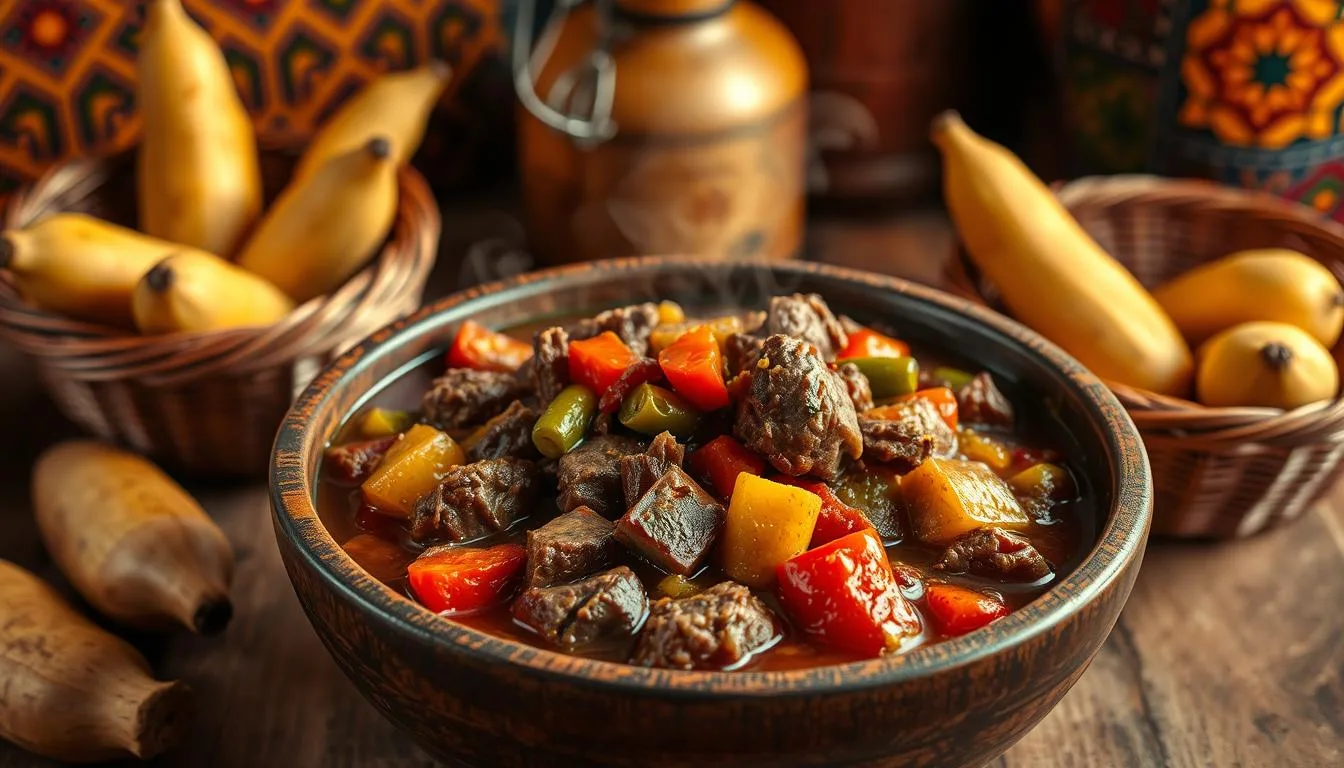Ever wondered why stews are so satisfying? Congo stew’s secret is its rich history, bold flavors, and the community it brings together. As a professional copywriter, I’m excited to share this journey with you. We’ll explore the authentic recipe and its cultural importance, making it a true comfort food.
Key Takeaways
- Discover the origins and cultural significance of the traditional Congo stew
- Learn about the key ingredients that make this dish a flavorful African comfort food
- Explore the step-by-step cooking techniques for preparing an authentic Congo stew
- Uncover tips and tricks for enhancing the flavors and avoiding common mistakes
- Discover the nutritional benefits and regional variations of this versatile dish
Table of Contents
What Is Congo Stew?
Congo stew, also known as African stew, is a beloved dish from the Democratic Republic of the Congo. It’s a hearty, flavorful stew that is a staple in Congolese cuisine. It holds significant cultural significance for the people of this region.
A Brief Overview of the Dish
Congo stew is made with protein-rich ingredients like chicken, beef, or fish. It also includes various vegetables and legumes.
These flavors come from spices and seasonings like chili peppers, onions, garlic, and palm oil. The stew is cooked low and slow. This allows the flavors to meld and develop into a rich, satisfying meal.
Cultural Significance of Congo Stew
- Congo stew is often served at important social gatherings, such as weddings, funerals, and celebrations. It plays a central role in bringing communities together.
- The dish is considered a symbol of hospitality. It’s frequently shared with guests as a way of welcoming them and showcasing the region’s culinary traditions.
- Preparing and sharing Congo stew is also seen as a way to preserve and pass down cultural knowledge and cooking techniques from one generation to the next.
In summary, Congo stew is a robust and flavorful dish with deep cultural significance for the people of the Democratic Republic of the Congo. Its rich history, diverse ingredients, and role in social gatherings make it an integral part of congolese cuisine and african stew traditions.
Key Ingredients for My Congo Stew
Creating a true Congo stew is all about the right ingredients. I’ve picked the best proteins, veggies, legumes, and spices. They bring out the true taste of this beloved dish.
Proteins to Include
My Congo stew starts with a mix of proteins. Here’s what I use:
- Chicken: Tender chicken thighs or drumsticks add flavor and texture.
- Peanut stew: I add peanut butter or roasted peanuts for a nutty taste.
- Beef: Cubed beef or oxtail make the stew hearty.
- Seafood: Shrimp, tilapia, or smoked fish add a seafood twist.
Vegetables and Legumes
I choose a variety of veggies and legumes for balance and color. Here’s what I pick:
- Sweet potatoes or yams: They add sweetness and creaminess.
- Tomatoes: Diced or pureed, they bring a tangy flavor.
- Onions and garlic: These are the base of the stew’s flavor.
- Leafy greens: Spinach, kale, or collard greens add nutrition and color.
- Beans or lentils: Kidney beans, black-eyed peas, or lentils make it hearty.
Spices and Seasonings
For authentic Congo stew flavors, I choose the right spices and seasonings. Here’s my list:
- Cumin: It adds depth and complexity.
- Chili powder: A bit of heat from chili powder or cayenne pepper is great.
- Ginger: Fresh ginger adds a warm, sweet aroma.
- Paprika: Smoked or sweet paprika enriches the stew’s flavor and color.
- Thyme: Fresh or dried thyme adds herbal notes.
By picking and mixing these ingredients, I aim to make a Congo stew that looks good and tastes amazing. It should take you straight to Central Africa.
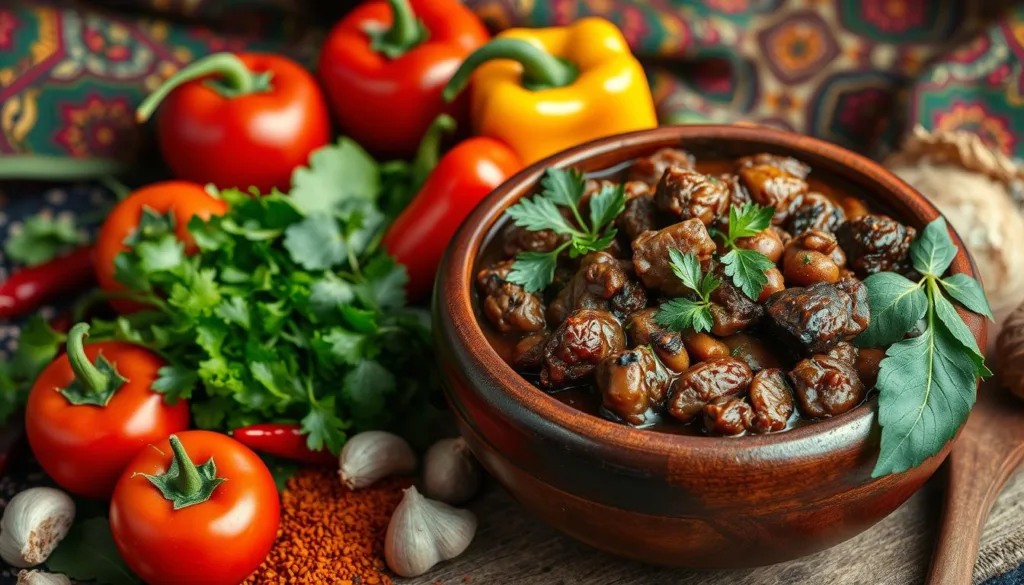
Preparing the Main Ingredients
Making the perfect congo stew recipe or chicken stew needs careful prep. I’ve learned to clean and cut veggies and handle proteins well. This ensures the dish tastes great and feels right in your mouth.
How I Clean and Cut Vegetables
I first rinse all veggies under cool water to get rid of dirt. For greens like spinach, I dry them with a towel before chopping. Root veggies like carrots get peeled and cut into even pieces for cooking.
Onions and garlic get peeled and minced to release their smell. Dicing tomatoes and slicing bell peppers need careful cutting for the right texture in the stew.
Tips for Cooking Proteins
In my congo stew recipe, I use chicken thighs or mix chicken and beef. I sear the proteins first to get a caramelized crust. It’s important to cook the proteins until they’re tender but still juicy.
By preparing veggies and proteins well, I create layers of flavor. This is the key to a delicious and authentic African-inspired stew.
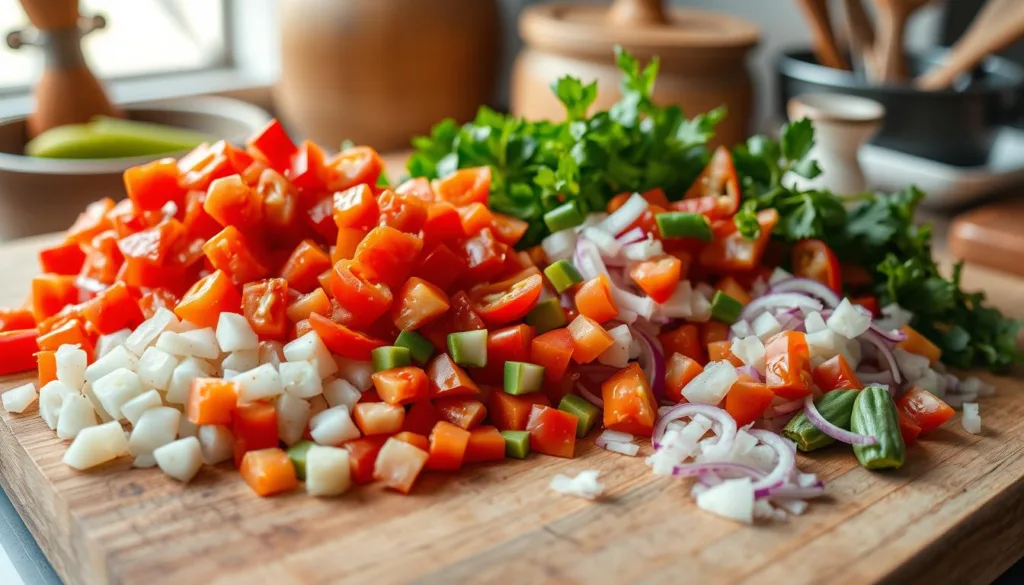
Cooking Techniques for Congo Stew
Making a tasty slow cooked stew like Congo stew is all about the techniques. As a seasoned home cook, I’ve learned a lot.
Sautéing vs. Stewing
Choosing between sautéing and stewing is a big decision for Congo stew. Both ways have their good points. It really depends on what you like and the texture you want.
Sautéing gives a richer, caramelized taste. Stewing makes the meat tender. I sauté the base first, then stew it slow to add depth.
Layering Flavors for Better Taste
Layering flavors is key in Congo stew. I start with sautéed onions, garlic, and spices. Then, I add more ingredients, layering the flavors.
Adding proteins, veggies, and herbs at the right time makes a big difference. This way, each part adds its own taste and texture. The result is a slow cooked stew that’s both rich and satisfying.
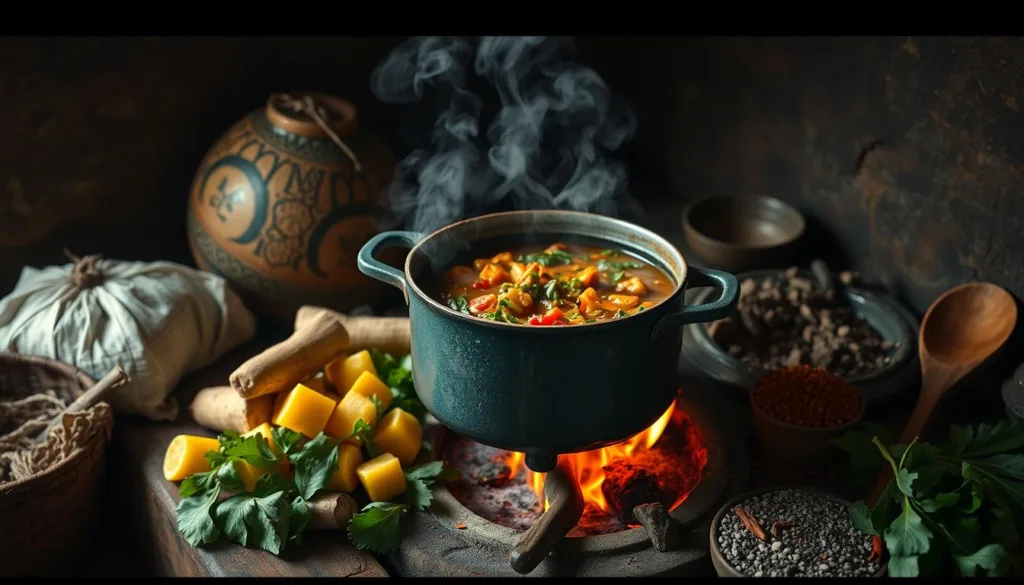
How to Make Congo Stew
Making the perfect congo stew recipe is like a craft. It needs careful attention and patience. I love this traditional African dish and want to show you how to make a tasty slow cooked stew. It will take you to the heart of the Congo with every bite.
Step-by-Step Cooking Instructions
- First, get all your ingredients ready. This includes proteins, veggies, and spices.
- Heat oil in a big pot over medium-high. Add diced onions.
- Then, add chopped garlic and ginger. Cook for a minute until the smell gets stronger.
- Put in the cubed meat or poultry. Brown it on all sides to keep the flavor in.
- Use broth to clean the pot.
- Add diced tomatoes, veggies, and legumes. Season with spices, salt, and pepper.
- Pour in enough liquid to cover everything. Bring it to a boil.
- Lower the heat to low, cover, and let it simmer for 45 minutes to an hour. This makes the meat and veggies tender.
- Check the stew and add more salt, pepper, or spices if needed.
- Finally, stir in chopped cilantro or parsley for extra flavor.
Cooking Time and Temperature
The secret to a great congo stew recipe is slow cooking. Keep the heat low, between 190°F and 210°F. This lets the flavors mix well and the ingredients get tender.
Letting the congo stew cook longer makes the flavors richer. Simmer it for to two hours. Just check it now and then and add more liquid if it gets too dry.
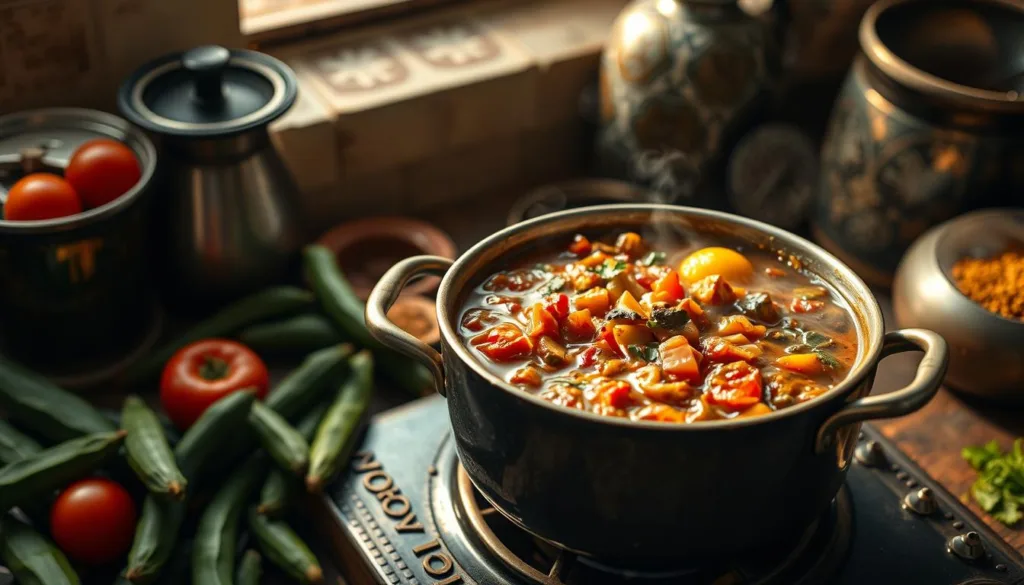
Tips for Enhancing Flavor
Creating the perfect spicy stew is all about choosing the right flavors. As someone who loves cooking African stew, I’ve tried many spice and herb mixes. These help make the dish even more delicious.
Personal Spice Blends I Love
I often use a spice mix for Congo stew. It has cumin, paprika, cayenne pepper, and garlic powder. The cumin adds a smoky taste, while paprika brings a sweet touch. Cayenne pepper adds heat, and garlic powder brings it all together.
Adding Fresh Herbs
- Fresh cilantro adds a bright, herbaceous note that cuts through the richness of the stew.
- Chopped parsley lends a fresh, grassy flavor and a pop of color to the dish.
- Fragrant thyme and rosemary can lend a subtle, earthy depth to the spicy stew.
Add A sprinkle of fresh herbs just before serving can really enhance the taste and smell of the Congo stew.
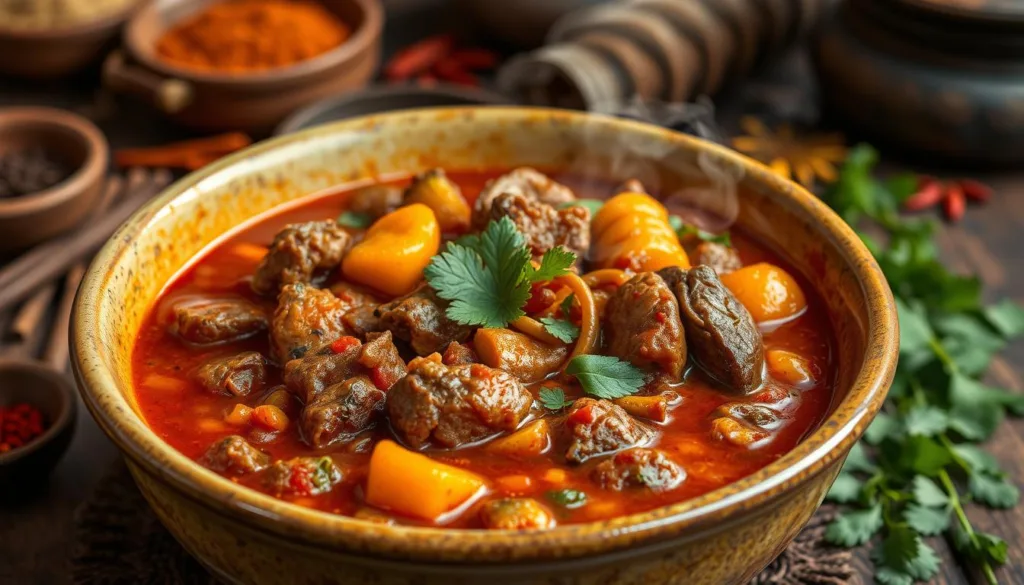
Trying out different spice blends and herbs can make your Congo stew special. By mixing these flavors, you can create a dish that’s both unique and tasty.
Common Mistakes to Avoid
Making the perfect congo stew recipe is more than just a list of ingredients. It’s about avoiding common mistakes to get the flavors and textures right. As a seasoned home chef, I’ve learned a few key lessons.
Overcooking Ingredients
One big mistake in congo stew is overcooking veggies and proteins. Okra and sweet potatoes can get mushy if cooked too long. Meat can also dry out and become tough. It’s important to watch cooking times closely to keep each ingredient’s texture and taste.
Underestimating Spice Levels
Congo stew is known for its bold, spicy taste. But, it’s easy to add too much spice. Too many chili peppers or spices can overpower the dish. Start with small amounts of spices and add more as needed to find the right balance.
- Adding a bit of sweetness, like honey or brown sugar, can help balance the heat.
- Offer extra spices on the side so everyone can adjust the spiciness to their taste.
Avoiding these mistakes will help you make a congo stew recipe that’s both tasty and spicy.
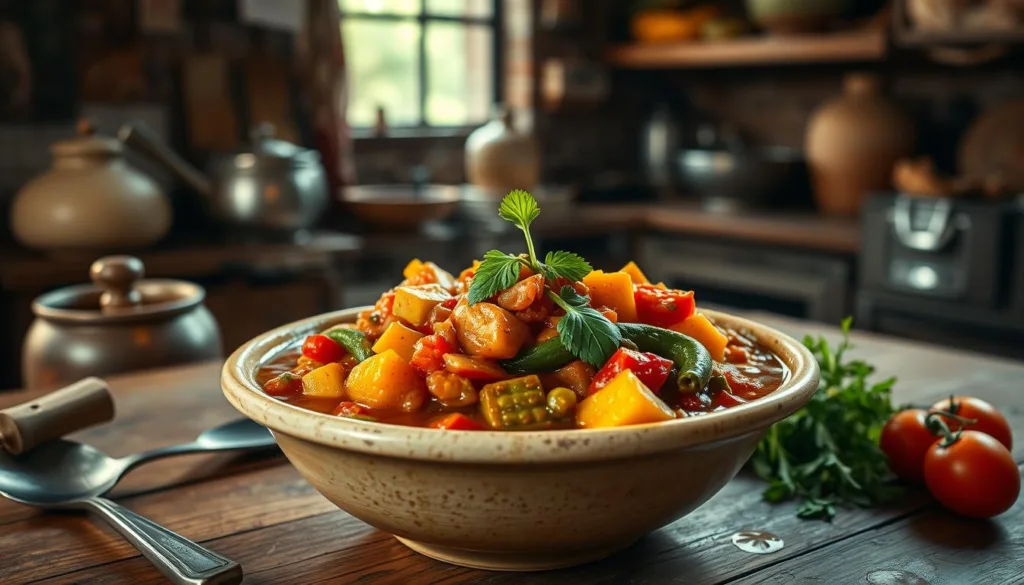
Serving Suggestions
When serving a tasty congolese cuisine dish, you have many options. Congo stew, a favorite african stew, goes well with many sides and drinks.
Traditional Sides to Pair
- Steamed white rice or fufu, a key food in Congolese cooking, is great for soaking up the stew’s broth.
- Creamy mashed cassava, a tasty root, adds a smooth touch to the stew.
- Crisp plantain chips or roasted plantains add a nice crunch and sweetness to the stew.
- A fresh vegetable salad with a tangy dressing can lighten the stew’s richness.
Best Beverages for Accompaniment
To match the flavors of the congolese cuisine, try these drinks with Congo stew:
- Ginger beer or spiced hibiscus tea offer a cool contrast to the stew.
- A chilled mango juice or pineapple smoothie adds a tropical flavor.
- For a true Congolese taste, try glass of palm wine or banana beer.
Choosing the right sides and drinks can make your congolese cuisine meal special. It celebrates the rich african stew traditions.
Storing Leftovers Safely
Enjoying Congo stew doesn’t have to stop when it’s finished. With the right storage, you can enjoy it for days. Here are my top tips for keeping your stew fresh and tasty.
Refrigeration Tips
Keep your Congo stew safe and tasty by refrigerating it quickly. Put the stew in airtight containers or bags. Make sure there’s little air inside.
This keeps moisture in and stops bad bacteria. Eat your stew within 3-4 days for the best taste.
Reheating Instructions
- When you’re ready to eat your leftover Congo stew, put some in a saucepan or microwave-safe bowl.
- On the stovetop, heat it gently over medium heat. Stir often until it’s hot all the way through.
- In the microwave, heat in 30-second bursts. Stir between each burst until it’s warm.
- Don’t overheat. This can make the stew dry and tough.
Follow these easy steps for storing and reheating your Congo stew. This way, you can enjoy its authentic flavors for days. Keeping food safe ensures your leftovers stay delicious and healthy.
Variations of Congo Stew
The traditional Congo stew is a comfort food loved by many. But, there are many ways to make it to fit different tastes and places. You can try a hearty vegetable stew, a peanut stew full of protein, or a zesty okra stew. This dish lets you get creative in the kitchen.
Vegetarian Options
If you want to enjoy Congo stew without meat, there are great options. A vegetable stew with potatoes, sweet potatoes, carrots, and greens is very satisfying.
Regional Influences on Ingredients
The ingredients in Congo stew change based on where you are. In some places, peanut stew is popular, with peanuts or peanut butter. In others, okra stew is favored, adding a special texture and taste.
Trying these different versions is a fun way to find new tastes. It also shows the rich food culture of the Congo. Whether you like the classic or something new, there’s a lot to explore with Congo stew.
Nutritional Benefits of Congo Stew
Congo stew is more than just a tasty dish. Whether it’s a vegetable stew or a chicken stew, it’s packed with goodness.
Health Benefits of Key Ingredients
The ingredients in Congo stew are full of vitamins and minerals. Leafy greens, root veggies, and lean proteins are all key. Spinach and kale add vitamins A, C, and K, plus iron and calcium.
Sweet potatoes and carrots boost beta-carotene. Chicken is low in fat but high in protein, helping your muscles.
Legumes like kidney beans or lentils add fiber and folate. These nutrients are great for your health.
Balancing a Meal with Stew
Congo stew can be the main part of a healthy meal. Add a side salad or steamed veggies for a balanced plate.
The stew’s filling nature helps you eat less. This can help you stay at a healthy weight and feel better overall.
My Favorite Congo Stew Stories
Growing up, Congo stew was always there, at family gatherings and celebrations. It was more than just food. It was a symbol of congolese cuisine and our family’s traditions.
Family Gatherings and Celebrations
My favorite memory is our annual family reunion. The kitchen buzzed with onions and spices. Watching my grandmother and aunts cook was magical.
They chopped vegetables and stirred the pot in perfect sync. It was a time of togetherness. We shared stories and laughed, enjoying Congo stew together.
Learning from Elders
My elders taught me the most about Congo stew. On lazy Sundays, I’d watch my grandmother prepare it. She shared her secrets, like the right spices and how to tenderize meat.
These lessons were about more than cooking. They were about keeping our culture alive. They taught me to appreciate congolese cuisine and our family’s history.
Congo stew’s stories are a big part of who I am. They remind me of my cultural heritage and the joy of sharing meals with loved ones.
Why I Love This Recipe
The Congo stew recipe is very special to me. It’s not just tasty, but also connects me to my family’s culture and memories. When I make this stew, I feel like I’m back in my childhood. The smell of cooking vegetables and spices reminds me of family gatherings.
Personal Connection to the Dish
My grandparents made this congo stew recipe for big events. We’d share stories and learn about our African roots. Every time I taste it, I remember the happiness in our home.
Memories Associated with Cooking
For me, cooking this african stew is a way to honor my family. I enjoy picking out ingredients and chopping veggies. It’s a calm activity that lets me think about my family’s cooking history.
Over time, I’ve added my own touches to the recipe. But the heart of this congo stew is our family’s tradition. It feeds both our bodies and souls, keeping our heritage alive and our memories close.
Final Thoughts on Congo Stew
As we end our journey with Congo stew, I feel grateful and excited. This dish from the Congo region shows the beauty of home-cooked meals.
Encouragement to Try It Yourself
If you haven’t tried Congo stew yet, I urge you to do it. With a bit of effort, you’ll make a dish that feels like a trip to Central Africa.
Inviting Others to Share Their Creations
After mastering Congo stew, share it with others. Food brings people together. By sharing our dishes, we keep cultural traditions alive. So, post your Congo stew on social media or swap recipes with friends. Let’s keep Congo stew’s spirit alive.

